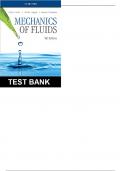Exam (elaborations)
Mechanics of Fluids SI Edition 5th Edition by Potter - Test Bank
- Institution
- Mechanics Of Fluids - Test Bank
Mechanics of Fluids Chapter 1: Basic Considerations Sections 1.4 – 1.7 1. The specific weight of air at 5 km is nearest: (A) 6.14 N/m3 (B) 6.66 N/m3 (C) 7.26 N/m3 (D) 8.22 N/m3 2. The specific gravity of an unknown liquid is known to be 1.26. The liquid is most likely: (A) Glycerin (B) Carb...
[Show more]



